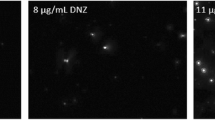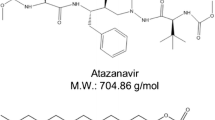Abstract
Purpose
Highly supersaturated aqueous solutions of poorly soluble compounds can undergo liquid-liquid phase separation (LLPS) when the concentration exceeds the “amorphous solubility”. This phenomenon has been widely observed during high throughput screening of new molecular entities as well as during the dissolution of amorphous solid dispersions. In this study, we have evaluated the use of environment-sensitive fluorescence probes to investigate the formation and properties of the non-crystalline drug-rich aggregates formed in aqueous solutions as a result of LLPS.
Methods
Six different environment-sensitive fluorophores were employed to study LLPS in highly supersaturated solutions of several model compounds, all dihydropyridine derivatives.
Results
Each fluoroprobe exhibited a large hypsochromic shift with decreasing environment polarity. Upon drug aggregate formation, the probes partitioned into the drug-rich phase and exhibited changes in emission wavelength and intensity consistent with sensing a lower polarity environment. The LLPS onset concentrations determined using the fluorescence measurements were in good agreement with light scattering measurements as well as theoretically estimated amorphous solubility values.
Conclusions
Environment-sensitive fluorescence probes are useful to help understand the phase behavior of highly supersaturated aqueous solutions, which in turn is important in the context of developing enabling formulations for poorly soluble compounds.













Similar content being viewed by others
Abbreviations
- ASDs:
-
Amorphous solid dispersions
- CMC:
-
Critical micelle concentration
- DASPEI:
-
2-(4-(dimethylamino)styryl) -N-Ethylpyridinium Iodide
- DMSO:
-
Dimethyl sulfoxide
- ESIPT:
-
Excited state intermolecular proton transfer
- HPMC:
-
Hydroxypropylmethyl cellulose
- HPMCAS:
-
Hydroxypropylmethyl cellulose acetate succinate
- ICT:
-
Intermolecular charge transfer
- IPA:
-
Isopropyl alcohol
- LLPS:
-
Liquid-liquid phase separation
- PLM:
-
Polarized light microscopy
- PRODAN:
-
4-(4-(Diethylamino)styryl) -N-Methylpyridinium Iodide (4-Di-2ASP) 6-Propionyl-2-dimethylaminonaphthalene
- PVP:
-
Polyvinylypyrrolidone
- TFA:
-
Trifluoroacetic acid
- UV:
-
Ultraviolet
References
Tachibana T, Nakamura A. A methode for preparing an aqueous colloidal dispersion of organic materials by using water-soluble polymers: dispersion ofΒ-carotene by polyvinylpyrrolidone. Kolloid-ZuZPolymere. 1965;203:130–3.
Aisha AFA, Ismail Z, Abu-salah KM, Majid AMSA. Solid dispersions of α-mangostin improve its aqueous solubility through self-assembly of nanomicelles. J Pharm Sci. 2012;101:815–25.
Friesen DT, Shanker R, Crew M, Smithey DT, Curatolo WJ, Nightingale JAS. Hydroxypropyl methylcellulose acetate succinate-based spray-dried dispersions: an overview. Mol Pharmaceutics. 2008;5:1003–19.
Alonzo DE, Gao Y, Zhou D, Mo H, Zhang GG, Taylor LS. Dissolution and precipitation behavior of amorphous solid dispersions. J Pharm Sci. 2011;100:3316–31.
Kanzer J, Hupfeld S, Vasskog T, Tho I, Hölig P, Mägerlein M, et al. In situ formation of nanoparticles upon dispersion of melt extrudate formulations in aqueous medium assessed by asymmetrical flow field-flow fractionation. J Pharm Biomed Anal. 2010;53:359–65.
Müllertz A, Ogbonna A, Ren S, Rades T. New perspectives on lipid and surfactant based drug delivery systems for oral delivery of poorly soluble drugs. J Pharm Pharmac. 2010;62:1622–36.
Pacheco LF, Carmona-Ribeiro AM. Effects of synthetic lipids on solubilization and colloid stability of hydrophobic drugs. J Colloid Interf Sci. 2003;258:146–54.
Sassene PJ, Knopp MM, Hesselkilde JZ, Koradia V, Larsen A, Rades T, et al. Precipitation of a poorly soluble model drug during in vitro lipolysis: characterization and dissolution of the precipitate. J Pharm Sci. 2010;99:4982–91.
Hsieh Y-L, Box K, Taylor LS. Assessing the impact of polymers on the pH-induced precipitation behavior of poorly water-soluble compounds using synchrotron wide angle X-ray scattering. J Pharm Sci. 2014;103:2724–35.
Hsieh Y-L, Ilevbare G, Van Eerdenbrugh B, Box K, Sanchez-Felix M, Taylor L. pH-induced precipitation behavior of weakly basic compounds: determination of extent and duration of supersaturation using potentiometric titration and correlation to solid state properties. Pharm Res. 2012;29:2738–53.
Coan KED, Shoichet BK. Stoichiometry and physical chemistry of promiscuous aggregate-based inhibitors. J Am Chem Soc. 2008;130:9606–12.
Zhang F, Roosen-Runge F, Sauter A, Roth R, Skoda MWA, Jacobs R, et al. The role of cluster formation and metastable liquid-liquid phase separation in protein crystallization. Faraday Discuss. 2012;159:313–25.
Veesler S, Lafferrère L, Garcia E, Hoff C. Phase transitions in supersaturated drug solution. Org Process Res Dev. 2003;7:983–9.
Raina SA, Zhang GGZ, Alonzo DE, Wu J, Zhu D, Catron ND, et al. Enhancements and limits in drug membrane transport using supersaturated solutions of poorly water-soluble drugs. J Pharm Sci. 2014;103:2736–48.
S.A. Raina, G.G.Z. Zhang, D.E. Alonzo, J. Wu, D. Zhu, N.D. Catron, Y. Gao, L.S. Taylor. Impact of Solubilizing Additives on Supersaturation and Membrane Transport of Drugs. Pharm Res (2015). doi:10.1007/s11095-015-1712-4
Raina SA, Eerdenbrugh BV, Alonzo DE, Mo H, Zhang GGZ, Gao Y, et al. Trends in the precipitation and crystallization behavior of supersaturated aqueous solutions of poorly water-soluble drugs assessed using synchrotron radiation. J Pharm Sci. 2015;104:1981–92.
Frank KJ WU, Rosenblatt KM, Hölig P, Rosenberg J, Mägerlein M, Fricker G, et al. The amorphous solid dispersion of the poorly soluble ABT-102 forms nano/microparticulate structures in aqueous medium: impact on solubility. Int J Nanomed. 2012;7:5757–68.
Frank KJ, Westedt U, Rosenblatt KM, Hölig P, Rosenberg J, Mägerlein M, et al. What is the mechanism behind increased permeation rate of a poorly soluble drug from aqueous dispersions of an amorphous solid dispersion? J Pharm Sci. 2014;103:1779–86.
Wang J, Matayoshi E. Solubility at the molecular level: development of a critical aggregation concentration (CAC) assay for estimating compound monomer solubility. Pharm Res. 2012;29:1745–54.
Taboada P, Attwood D, Ruso JM, Garcia M, Mosquera V. Static and dynamic light scattering study on the association of some antidepressants in aqueous electrolyte solutions. Phys Chem Chem Phys. 2000;2:5175–9.
Van Eerdenbrugh B, Alonzo DE, Taylor LS. Influence of particle size on the ultraviolet spectrum of particulate-containing solutions: implications for in-situ concentration monitoring using UV/Vis fiber-optic probes. Pharm Res. 2011;28:1643–52.
Sugano K, Kato T, Suzuki K, Keiko K, Sujaku T, Mano T. High throughput solubility measurement with automated polarized light microscopy analysis. J Pharm Sci. 2006;95:2115–22.
Qi S, Roser S, Edler K, Pigliacelli C, Rogerson M, Weuts I, et al. Insights into the role of polymer-surfactant complexes in drug solubilisation/stabilisation during drug release from solid dispersions. Pharm Res. 2013;30:290–302.
Gao X, Huang Y, Makhov AM, Epperly M, Lu J, Grab S, et al. Nanoassembly of surfactants with interfacial drug-interactive motifs as tailor-designed drug carriers. Mol Pharmaceutics. 2012;10:187–98.
Giannetti AM, Koch BD, Browner MF. Surface plasmon resonance based assay for the detection and characterization of promiscuous inhibitors. J Med Chem. 2008;51:574–80.
Abbou Oucherif K, Raina S, Taylor LS, Litster JD. Quantitative analysis of the inhibitory effect of HPMC on felodipine crystallization kinetics using population balance modeling. CrystEngComm. 2013;15:2197–205.
Raina SA, Alonzo DE, Zhang GGZ, Gao Y, Taylor LS. Impact of polymers on the crystallization and phase transition kinetics of amorphous nifedipine during dissolution in aqueous media. Mol Pharmaceutics. 2014;11:3565–76.
Baird JA, Van Eerdenbrugh B, Taylor LS. A classification system to assess the crystallization tendency of organic molecules from undercooled melts. J Pharm Sci. 2010;99:3787–806.
Ilevbare GA, Taylor LS. Liquid–liquid phase separation in highly supersaturated aqueous solutions of poorly water-soluble drugs: implications for solubility enhancing formulations. Cryst Growth Des. 2013;13:1497–509.
Hoffman JD. Thermodynamic driving force in nucleation and growth processes. J Chem Phys. 1958;29:1192–3.
Murdande SB, Pikal MJ, Shanker RM, Bogner RH. Solubility advantage of amorphous pharmaceuticals: I. A thermodynamic analysis. J Pharm Sci. 2010;99:1254–64.
Murdande SB, Pikal MJ, Shanker RM, Bogner RH. Solubility advantage of amorphous pharmaceuticals, part 3: Is maximum solubility advantage experimentally attainable and sustainable? J Pharm Sci. 2011;100:4349–56.
Murdande S, Pikal M, Shanker R, Bogner R. Solubility advantage of amorphous pharmaceuticals: II. Application of quantitative thermodynamic relationships for prediction of solubility enhancement in structurally diverse insoluble pharmaceuticals. Pharm Res. 2010;27:2704–14.
Alonzo D, Zhang GZ, Zhou D, Gao Y, Taylor L. Understanding the behavior of amorphous pharmaceutical systems during dissolution. Pharm Res. 2010;27:608–18.
Ndouand TT, von Wandruszka R. Pyrene fluorescence in premicellar solutions: the effects of solvents and temperature. J Lumin. 1990;46:33–8.
Chandar P, Somasundaran P, Turro NJ. Fluorescence probe investigation of anionic polymer-cationic surfactant interactions. Macromolecules. 1988;21:950–3.
Goddard ED, Turro NJ, Kuo PL, Ananthapadmanabhan KP. Fluorescence probes for critical micelle concentration determination. Langmuir. 1985;1:352–5.
Zana R, Yiv S, Strazielle C, Lianos P. Effect of alcohol on the properties of micellar systems: I. Critical micellization concentration, micelle molecular weight and ionization degree, and solubility of alcohols in micellar solutions. J Colloid Interf Sci. 1981;80:208–23.
Jensen KHR, Rekling JC. Development of a no-wash assay for mitochondrial membrane potential using the styryl Dye DASPEI. J Biomol Screen. 2010;15:1071–81.
Lakowicz JR. Principles of fuorescence spectroscopy. New York: Springer; 2006.
Marini A, Muñoz-Losa A, Biancardi A, Mennucci B. What is solvatochromism? J Phys Chem B. 2010;114:17128–35.
Pávez P, Encinas MV. Photophysics and photochemical studies of 1,4-dihydropyridine derivatives. Photochem Photobiol. 2007;83:722–9.
Fasani E, Dondi D, Ricci A, Albini A. Photochemistry of 4-(2-nitrophenyl)-1,4-dihydropyridines. Evidence for electron transfer and formation of an intermediate. Photochem Photobiol. 2006;82:225–30.
Van Eerdenbrugh B, Raina S, Hsieh Y-L, Augustijns P, Taylor L. Classification of the crystallization behavior of amorphous active pharmaceutical ingredients in aqueous environments. Pharm Res. 2014;31:969–82.
ACKNOWLEDGMENTS AND DISCLOSURES
We would like to acknowledge AbbVie Inc. for providing research funding for this project.
Purdue University and AbbVie jointly participated in study design, research, data collection, analysis and interpretation of data, writing, reviewing, and approving the publication. Lynne S. Taylor is a professor at Purdue University, and has no additional conflicts of interest to report. David A. Alonzo is an employee at Gilead Sciences, Inc. and has no additional conflicts of interest to report. Shweta A. Raina, Geoff G. Z. Zhang and Yi Gao are employees of AbbVie and may own AbbVie stock.
Author information
Authors and Affiliations
Corresponding author
Rights and permissions
About this article
Cite this article
Raina, S.A., Alonzo, D.E., Zhang, G.G.Z. et al. Using Environment-Sensitive Fluorescent Probes to Characterize Liquid-Liquid Phase Separation in Supersaturated Solutions of Poorly Water Soluble Compounds. Pharm Res 32, 3660–3673 (2015). https://doi.org/10.1007/s11095-015-1725-z
Received:
Accepted:
Published:
Issue Date:
DOI: https://doi.org/10.1007/s11095-015-1725-z




